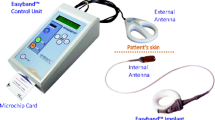Abstract.
Introduction: Two different adjustable silicone gastric bandings were laparoscopically applied and compared regarding per- and postoperative complications and successful weight loss. Patients and methods: A total of 120 consecutive patients received a laparoscopic adjustable gastric banding and were prospectively documented. In the learning phase (LP) 50 patients were treated with an Adjustable Silicone Gastric Banding (ASGB, Bioenterics) using an intragastric balloon calibration technique according to Belachew. Group I (n = 29) received the same band using a surgical technique with tunneling behind the oesophagus towards His' angle, while the second group (n = 41) received a Swedish Adjustable Gastric Banding (SAGB), using the same technique as in group I. A BMI of > 35, complications secondary to obesity and failed diets were the indication for the operation. Thirty patients were male, 90 female, with a mean age of 37 years (18–60). Results: In the LP 8 patients had to be reoperated (16 %) for band slippage and/or pouch dilatation, in group I 6 (19 %) and in group II 1 (3 %) (P = 0.02, II vs I). The mean hospital stay was 3.7 ± 0.5, 3.4 ± 0.8 and 3.3 ± 0.4 days in LP, I und II, respectively. Long-term results: After a mean of 24 months (19–42) the loss of body weight was 8.4 kg after 3, 13.9 kg after 6, 22.1 kg after 12 and 27.8 kg after 18 months in the LP. In group I after a mean of 14 months (12–19) 10.3 kg after 3, 18.7 kg after 6, 24.8 kg after 12 months. In group II after a mean of 10 months (6–16) the loss of body weight was 7.9 kg after 3 and 19.4 kg after 6 months. Conclusion: In our experience it appears that the SAGB is easy to handle and less prone to complications such as dysphagia and slipping, probably due to good fixation of the band due to its width. A prospective randomized trial is warranted.
Zusammenfassung.
Einleitung: Zwei verschiedene Bänder zur laparoskopischen Anlage am Magen wurden an 2 Patientenkollektiven im Hinblick auf peri- und postoperative Komplikationen und den Erfolg der Gewichtsreduktion untersucht. Patienten und Methoden: 120 Patienten wurden behandelt und prospektiv dokumentiert. In der Lernphase (LP) handelte es sich um 50 Fälle des anpassbaren Silicon Gastric Bandings (ASGB, Bioenterics®). Das Band wurde nach der Technik von Belachew im Bereich der distalen Magenkardia angelegt. In Gruppe I (n = 29) wurde das gleiche Band in der Technik von Forsell angelegt. In Gruppe II (n = 41) wurde das Schwedische anpassbare Gastric Banding (SAGB, Obtech®) nach der Methode von Forsell angelegt. Als Indikation zur Operation wurde ein Body Mass Index (BMI) über 35 sowie sekundäre Komplikationen der Obesitas und gescheiterte konservative Gewichtsreduktionstherapien angesehen. 30 Patienten waren männlich, 90 weiblich mit einem gemittelten Alter von 37 Jahren (18–60). Resultate: In der LP mussten 8 Patienten wegen eines Bandslipping und/oder Pouchdilatation reoperiert werden (16 %), in Gruppe I 6 (19 %) und in Gruppe II 1 (3 %) (p = 0,02, II vs I). Der gemittelte Krankenhausaufenthalt betrug 3,7 ± 0,5, 3,4 ± 0,8 und 3,3 ± 0,4 Tage in der LP, I und II respektive. Langzeitresultate: Nach einer Beobachtungszeit von gemittelt 24 Monaten (19–42) betrug der Gewichtsverlust 8,4 kg nach 3, 13,9 kg nach 6, 22,1 kg nach 12 Monaten und 27,8 kg nach 18 Monaten in der LP. In Gruppe I nach gemittelt 14 Monaten (12–19) 10,3 kg nach 3, 18,7 kg nach 6, 24,8 kg nach 12 Monaten. In Gruppe II nach gemittelt 10 Monaten (6–16) betrug die Gewichtsreduktion 7,9 kg nach 3 und 19,4 kg nach 6 Monaten. Schlussfolgerung: In unserer Erfahrung erscheint die Anlage des SAGB leicht durchzuführen und weniger komplikationsanfällig zu sein im Hinblick auf Dysphagie und Slipping des Bandes vermutlich wegen der guten Fixation des Bandes auf Grund seiner Breite. Eine prospektiv randomisierte Studie ist erforderlich.
Similar content being viewed by others
Author information
Authors and Affiliations
Rights and permissions
About this article
Cite this article
Hesse, U., Berrevoet, F., Ceelen, W. et al. Das anpassbare Silicon Gastric Banding (ASGB, Bioenterics®) und das Schwedische anpassbare Gastric Banding (SAGB, Obtech®) zur Behandlung der morbiden Obesitas. Chirurg 72, 14–18 (2001). https://doi.org/10.1007/s001040051261
Issue Date:
DOI: https://doi.org/10.1007/s001040051261




